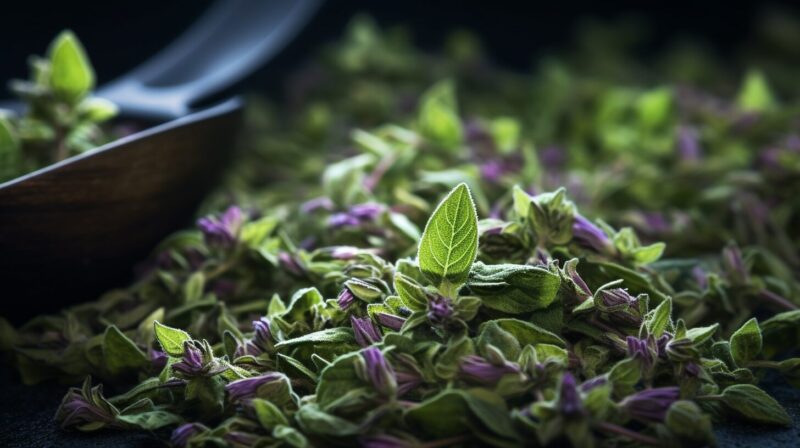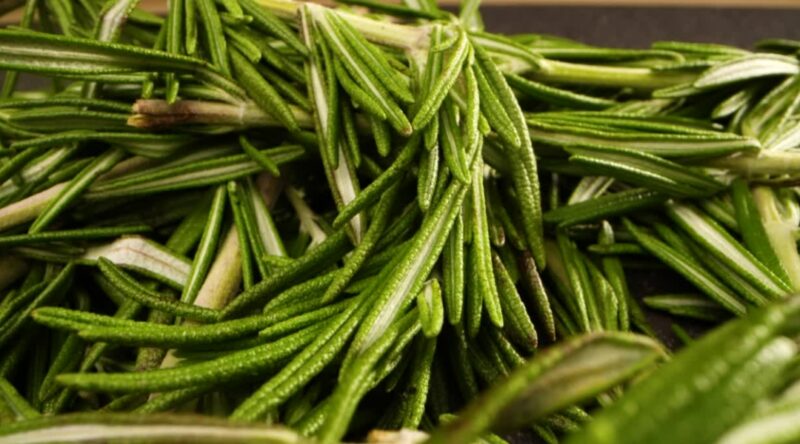
We’ve all been there: in the midst of preparing a delightful meal, only to discover that the sage jar is empty. It’s one of those culinary hiccups that can momentarily halt our cooking momentum. But here’s the good news: the world of herbs is vast and varied, and there are several that can step in as worthy replacements for sage.
Over the years, I’ve experimented with a myriad of alternatives, each bringing its own unique flavor profile to the table. Whether you’re crafting a traditional roast, a hearty stew, or a contemporary pasta creation, having a few sage substitutes up your sleeve can truly be a lifesaver.
So, before you panic join me in sharing these fantastic alternatives. By the end of this, you’ll be equipped with the knowledge to make your dishes shine, sage or no sage.
Sage in the Kitchen
Sage in itself is an excellent herb that has been used throughout the ages by even the Romans and the Greeks and has remained popular in use all the way into the present. It has been used in many different ways, from preserving to culinary and even to medicine.
The herb has unique qualities that can increase one’s memory and even is used when treating patients who have been diagnosed with Alzheimer’s. It’s so well known for this fact that when one made tea from the leaves of a sage’s leaves, it was named “A Thinker’s Tea.”
One of the things that sage is really known for is the fact that it is very fragrant, and many people often use this to enhance the scent of the meal to make it more appealing. However, despite its delicious smell, it provides a small blend of bitterness to the food, which is why I often recommend having it paired with cheese.
1. Oregano

When you’re out of sage and looking for a worthy substitute, oregano often comes to the rescue. With its strong flavor, warmth, and a hint of subtle sweetness, oregano can seamlessly blend into various dishes. Whether fresh, dried, or in oil form, oregano not only enhances the taste but also offers significant health benefits.
| Benefit | Description |
|---|---|
| Rich in Antioxidants | Oregano is packed with antioxidants that help combat damage from harmful free radicals in the body. These free radicals are linked to chronic diseases like cancer and heart disease. |
| Antibacterial Properties | Oregano contains compounds that have shown potent antibacterial properties, effectively blocking the growth of harmful bacteria strains. |
| Anti-Cancer Properties | Some studies suggest that oregano and its components may help kill cancer cells, potentially aiding in cancer prevention. |
| Antiviral Properties | Compounds in oregano, particularly carvacrol and thymol, have been associated with antiviral properties, offering protection against certain viruses. |
| Anti-Inflammatory | Oregano is rich in compounds like carvacrol that have demonstrated anti-inflammatory properties, potentially reducing inflammation in the body. |
Dishes Perfect for Oregano
- Mediterranean Pasta Salad
- Herb-Crusted Roast Chicken
- Greek-style Lemon Potatoes
- Tomato and Oregano Bruschetta
- Zesty Oregano and Olive Tapenade
2. Basil

Basil, with its origins in India, Asia, and Africa, has long been revered as a noble herb. With a name derived from the ancient Greek word “basilikhon,” meaning “royal,” basil has made its mark in cuisines worldwide.
From the aromatic sweet basil to the tangy lemon basil and refreshing mint basil, this herb is a versatile addition to any kitchen. Its distinctive aroma and flavor make it a delightful alternative to sage in various dishes.
| Benefit | Description |
|---|---|
| Rich in Antioxidants | Basil is abundant in antioxidants like eugenol, limonene, anthocyanins, and beta-carotene, which combat harmful free radicals in the body. |
| Blood Sugar Regulation | Some studies suggest basil may help reduce high blood sugar levels, potentially mitigating the long-term effects of elevated blood sugar. |
| Heart Disease Prevention | Basil’s eugenol content can help lower blood pressure. Its essential oils can also reduce cholesterol and triglyceride levels. |
| Reduced Inflammation | Basil’s essential oils, including eugenol, linalool, and citronellol, possess anti-inflammatory properties, potentially reducing the risk of conditions like arthritis. |
| Protection Against Infections | Basil exhibits antibacterial properties, potentially aiding in combating respiratory, urinary, abdominal, or skin infections. |
Dishes Perfect for Basil
- Caprese Salad
- Basil Pesto Pasta
- Tomato Basil Soup
- Thai Basil Chicken
- Margherita Pizza
3. Savory
Basil, with its origins in India, Asia, and Africa, has long been revered as a noble herb. With a name derived from the ancient Greek word “basilikhon,” meaning “royal,” basil has made its mark in cuisines worldwide.
From the aromatic sweet basil to the tangy lemon basil and refreshing mint basil, this herb is a versatile addition to any kitchen. Its distinctive aroma and flavor make it a delightful alternative to sage in various dishes.
| Benefit | Description |
|---|---|
| Rich in Antioxidants | Basil is abundant in antioxidants like eugenol, limonene, anthocyanins, and beta-carotene, which combat harmful free radicals in the body. |
| Blood Sugar Regulation | Some studies suggest basil may help reduce high blood sugar levels, potentially mitigating the long-term effects of elevated blood sugar. |
| Heart Disease Prevention | Basil’s eugenol content can help lower blood pressure. Its essential oils can also reduce cholesterol and triglyceride levels. |
| Reduced Inflammation | Basil’s essential oils, including eugenol, linalool, and citronellol, possess anti-inflammatory properties, potentially reducing the risk of conditions like arthritis. |
| Protection Against Infections | Basil exhibits antibacterial properties, potentially aiding in combating respiratory, urinary, abdominal, or skin infections. |
Dishes Perfect for Basil
- Caprese Salad
- Basil Pesto Pasta
- Tomato Basil Soup
- Thai Basil Chicken
- Margherita Pizza
4. Thyme

Thyme, a member of the mint family, has been a cornerstone in culinary traditions for centuries. Its subtle yet distinct flavor profile makes it a versatile herb, suitable for a wide range of dishes. When sage is not within arm’s reach, thyme can step in, offering a delightful aromatic touch that can elevate your culinary creations.
| Benefit | Description |
|---|---|
| Rich in Antioxidants | Thyme is packed with compounds that help combat harmful free radicals in the body, potentially reducing the risk of chronic diseases. |
| Anti-inflammatory Properties | Thyme’s essential oils, such as eugenol, have demonstrated anti-inflammatory properties, which can be beneficial against conditions like arthritis. |
| Protection Against Infections | Thyme showcases antibacterial properties, potentially aiding in combating respiratory, urinary, abdominal, or skin infections. |
| Blood Sugar Regulation | Some research suggests that thyme may assist in reducing high blood sugar levels, offering potential benefits for those with diabetes. |
| Heart Disease Prevention | Thyme’s eugenol content can help lower blood pressure, and its essential oils may contribute to reduced cholesterol levels. |
Dishes Perfect for Thyme
- Thyme-Roasted Chicken
- Lemon and Thyme Risotto
- Thyme and Garlic Roasted Potatoes
- Mushroom and Thyme Soup
- Thyme-Infused Olive Oil Pasta
5. Marjoram

Marjoram, scientifically known as Origanum majorana, is an aromatic herb celebrated for its citrus and pine flavors. Indigenous to the Middle Eastern and Mediterranean regions, marjoram has been a cherished addition to various cuisines. Its gentle yet distinct flavor profile makes it a suitable alternative to sage, especially when a milder touch is desired in a dish.
| Benefit | Description |
|---|---|
| Rich in Antioxidants | Marjoram contains compounds that help combat harmful free radicals in the body, potentially reducing the risk of chronic diseases. |
| Anti-inflammatory Properties | Marjoram has been shown to possess anti-inflammatory properties, beneficial in mitigating conditions like arthritis. |
| Protection Against Infections | Marjoram exhibits antibacterial properties, potentially aiding in combating infections, including those caused by E.coli bacteria. |
| Hormonal Health | Marjoram may be beneficial to hormonal health, especially for women. It has shown potential in improving insulin sensitivity and reducing adrenal androgen levels in women with PCOS. |
| Anxiety Relief | Marjoram has demonstrated anxiolytic, or anxiety-reducing, properties, enhancing the anxiety-reducing effects of certain therapies. |
Dishes Perfect for Marjoram
- Green Beans with Marjoram
- Goat Cheese and Marjoram Spread
- Marjoram Frittata
- Roasted Cauliflower with Marjoram
- Marinated Mushrooms
6. Rosemary

Rosemary, an evergreen herb native to the Mediterranean, has been a cherished addition to culinary and medicinal traditions for centuries. Its pine-like aroma and slightly peppery flavor make it a versatile herb in the kitchen. When sage isn’t available, rosemary can be a fantastic stand-in, bringing its own unique character to a dish.
| Benefit | Description |
|---|---|
| Rich in Antioxidants | Rosemary contains compounds that help combat harmful free radicals in the body, potentially reducing the risk of chronic diseases. |
| Anti-inflammatory Properties | Rosemary’s essential oils, such as eugenol, have demonstrated anti-inflammatory properties, beneficial in mitigating conditions like arthritis. |
| Protection Against Infections | Rosemary showcases antibacterial properties, potentially aiding in combating infections, including those caused by E.coli bacteria. |
| Enhancing Memory and Concentration | The aroma from rosemary can improve a person’s concentration, performance, speed, and accuracy. |
| Neurological Protection | Rosemary contains carnosic acid, which can fight off damage by free radicals in the brain. It may also be protective against brain damage and help in recovery after a stroke. |
Dishes Perfect for Rosemary
- Rosemary Garlic Roast Beef
- Lemon Rosemary Grilled Chicken
- Rosemary Olive Focaccia
- Potato Rosemary Soup
- Rosemary and Parmesan Baked Zucchin
FAQ

What is the nutritional value of sage?
Sage is a nutrient-rich herb. It contains a variety of essential nutrients such as vitamin K, vitamin A, calcium, iron, and more. It’s also a good source of antioxidants, which can help protect your body from damage by free radicals.
What are the medicinal uses?
Sage has been used in traditional medicine for centuries. It’s known for its antimicrobial, anti-inflammatory, and antioxidant properties. It’s often used to help soothe sore throats, improve brain function, and aid digestion. However, it’s always best to consult with a healthcare professional before using sage or any herb for medicinal purposes.
Can I use sage essential oil in cooking?
Sage essential oil is highly concentrated and should be used with caution. It’s not typically used in cooking due to its potency. Instead, it’s often used in aromatherapy or diluted and applied topically for its potential health benefits.
What are the differences between fresh and dried sage?
Fresh sage has a more mild and delicate flavor compared to dried sage, which is more concentrated and robust. When substituting dried sage for fresh in a recipe, use about one-third of the amount called for.
What are the potential side effects of consuming too much sage?
While sage is generally safe to consume in moderate amounts, consuming too much can lead to side effects such as dry mouth, throat irritation, dizziness, and even seizures in rare cases. It’s always best to consume herbs like sage in moderation.
Conclusion
There’s always going to be something that allows you to differentiate the herbs. It can be their smell, or it can be their taste, so you can’t always just add in any random spice that you find on one of your shelves, because the result might not end up the same and it could be probably the factor that ruins your dish!
With so many spices in this world, there should be no problem if you run out of sage in your kitchen. With the full range of possibilities, it shouldn’t be hard to find a substitute.
Of course, there will be a few adjustments like changing the amount of herb you will use or if you should use it fresh or dried, but nonetheless, with these replacements, you will still be getting the same effect as you would when adding in sage, just remember to follow the instructions and everything should go as planned!
Related Posts:
- What Can You Use as Chili Paste Substitute? - Best…
- 11 Parsley Substitutes That a Cook Should Know -…
- 11 Best Substitutes for Peanut Oil Used in Frying -…
- 9 Substitutes for Ricotta Cheese that Will Make Your…
- Different Ways to Use Himalayan Salt Block In Your Kitchen
- How Much Electricity Do Kitchen Exhaust Fans Use:…




















